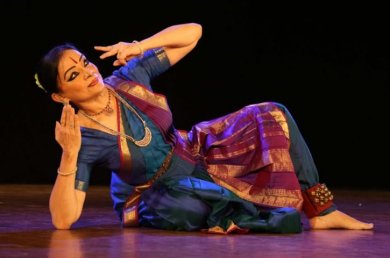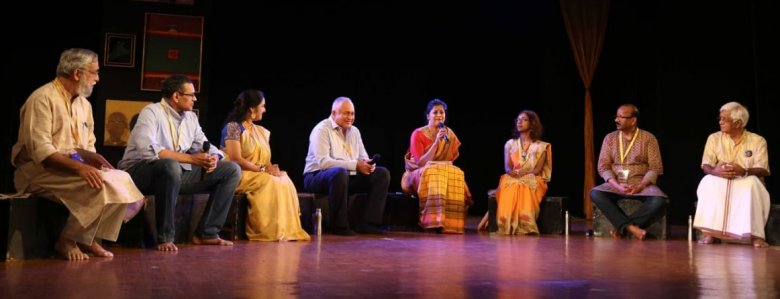
|   |

|   |
Impressions The Natya Kala Conference 2019: Day I - Dec 26, 2019 - Jeetendra Krishna e-mail: sathirdance@gmail.com Dec 29, 2019 The most awaited dance event of the year in Chennai is certainly the annual Natya Kala Conference (NKC). The conference is presented by the Krishna Gana Sabha, with this year's 39th edition conceptualised and convened by easily the most recognisable practitioner of present day Bharatanatyam, Rama Vaidyanathan. I have watched Rama perform for about twenty years now, with one of the first time performance in Amsterdam. Rama has conceptualised the conference with the title, Nirikshana: Bharatanatyam under the magnifying glass. Creative collaborator for the conference is Akhila Krishnamurthy's Alaap. The conference, curated over five days, from December 26 till December 30 has twenty-six carefully designed presentations, lectures, and performances. This year's conference has not only attracted dancers and art lovers from all over India, but additionally from at least twenty other countries! With the conference, the convener seeks to examine, probe and asses Bharatanatyam as it is presented today -to look at Bharatanatyam through two different lenses; one that investigates and reflects upon Nirikshana through the perspective of a concave lens that examines the depth of the dance with a microscope vision, and secondly with a convex lens that expands the mind with a macroscopic vision. I personally have not missed an edition of the NKC since 1989. This year, things are a bit different! After a stint in the 1990s, the conference is ticketed again and you can only enter after registration and wearing a delegate tag. Outside the auditorium, there is plenty of food available and there is a mini market with stalls that sell dance related items. The inauguration of the conference was soulfully opened with a Ranga Stuthi from the Abhinaya Darpana by eminent vocalist, O.S. Arun, followed by conferring the 'Natya Kala Vishaarada ha" award upon veteran Bharatanatyam guru Ranganayaki Jayaraman for her exemplary contribution to the dance form. In her keynote address, Rama spoke of why she exclusively focused on Bharatanatyam for this year's conference. Bharatanatyam is the most sought after classical dance style of India, and it is rapidly unfolding with dance schools in all major cities around the world, and a large number of performances on not only the proscenium stages but also studio and chamber concerts. She further stressed that this global Bharatanatyam boom also comes with its drawbacks and uncertainties. The increase in the number of performance opportunities has led to dwindling audiences. Next to high levels of excellence in dance stands a thriving mediocrity. There is diminishing of art critiquing in print media, dancers who are paid to perform and dancers who have to pay to perform. "A chaotic bliss of order and disorder" as Rama rightly put it. Bharatanatyam attracts so much attention that it warrants for deliberate in-depth assessment. In her inaugural address, chief guest Dr. Sonal Mansingh, who interestingly presented Odissi for the first time way back in 1969 at the Krishna Gana Sabha, shared that Nirikshana is an attempt to know yourself, an exercise in knowing yourself as a dancer or as a rasika; dance being a visual art it needs the eyes of the rasika. The dancer offers her art and the rasika should receive it by not merely seeing the dance but imbibing the dance. When all this happens simultaneously, the dancer disappears and only the dance remains, even if only for a fleeting moment. The first conference session opened with a bang by bringing back together veteran 'dance buddies', Padma Subrahmanyam, Sudharani Raghupathy and Chitra Visweswaran, re-visiting the Viralimalai Kuravanji originally researched and revived by Shyamala Balakrishnan in 1962. This particular Kuravanji dates from the pre Tyagaraja era, and is preserved with the original musical score. Shyamala Balakrishnan studied the Kuravanji with two devadasis of the Viralimalai temple. During the session, an archival film of 1987 (courtesy Doordarshan) with excerpts of the Kuravanji was screened, and in a pleasant surprise for us in the audience one of the Kuravanji scenes was presented spontaneously on stage by the veteran dancers and musicians. The presentation ended with a standing ovation and thunderous applause from the audience.  Malavika Sarukkai 'The Expanding Canvas' by Malavika Sarukkai was a presentation of excerpts of her imaginative choreographies; an exploration outside the Margam repertoire. She spoke of the larger vision of her art, of body and mind alignment, harmony or perfect 'sruti', which the artiste can only attain through years of intense dedication. She further spoke of the depiction of reality or realism in dance, imagination that comes from deep inspiration. Of how to express the nature of an animal or a bird, say a deer for example - how does the artiste do it? "Deer-Ness" - to feel like the deer yourself, to give the impression of the deer as though anybody can find it in you. This concept of entering the inner consciousness of a deer and to portray its essence was spoken of by Rukmini Devi, many decades ago.  Panel The next session was a panel discussion on 'Dance curation; concerns and challenges.' The discussion was moderated by the vibrant Akhila Krishnamurthy with dance festival curators from Chennai, Mumbai, Bangalore, Singapore and New York. In the lively discussion several burning questions passed the revue. Questions in reference to transparency in curation, each panel member explained their individual process that leads to the final selection of the performing artist. How to tackle the dwindling audiences, lack of production funds, mediocrity in dance and so on. The sensitive subject of 'paying to perform' was also touched upon but according to the festival curators there seems no element of truth to this, and dancers are purely selected on merit... Although it was an interesting discussion it only brought up more questions. The first day of the conference was successfully closed with the première dance production, Nibandhana by Vaibhav Arekar and the Sankhya Dance Company of Mumbai. Jeetendra Krishna, Sathir Dance Art Trust, Amsterdam-Chennai. |